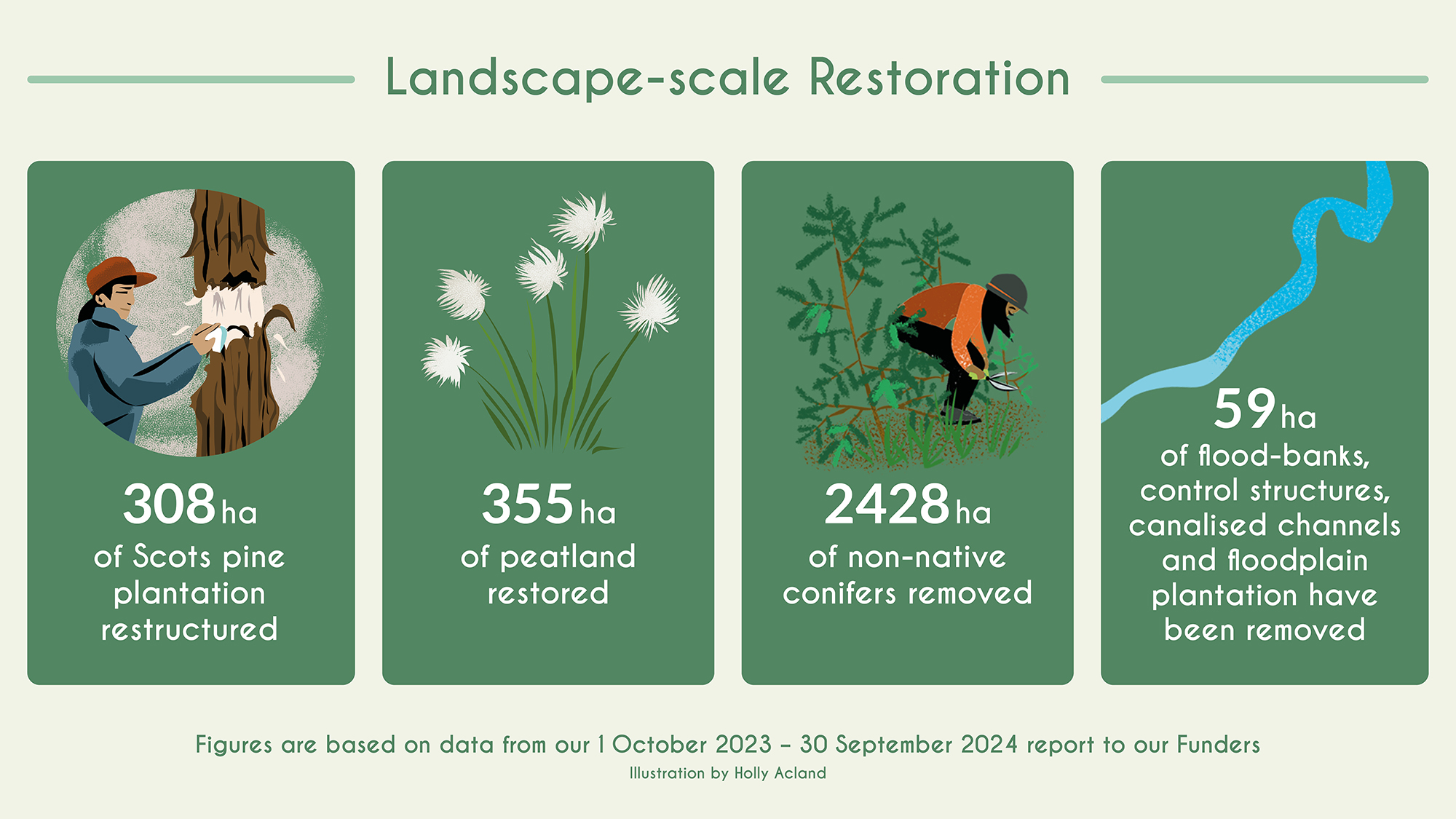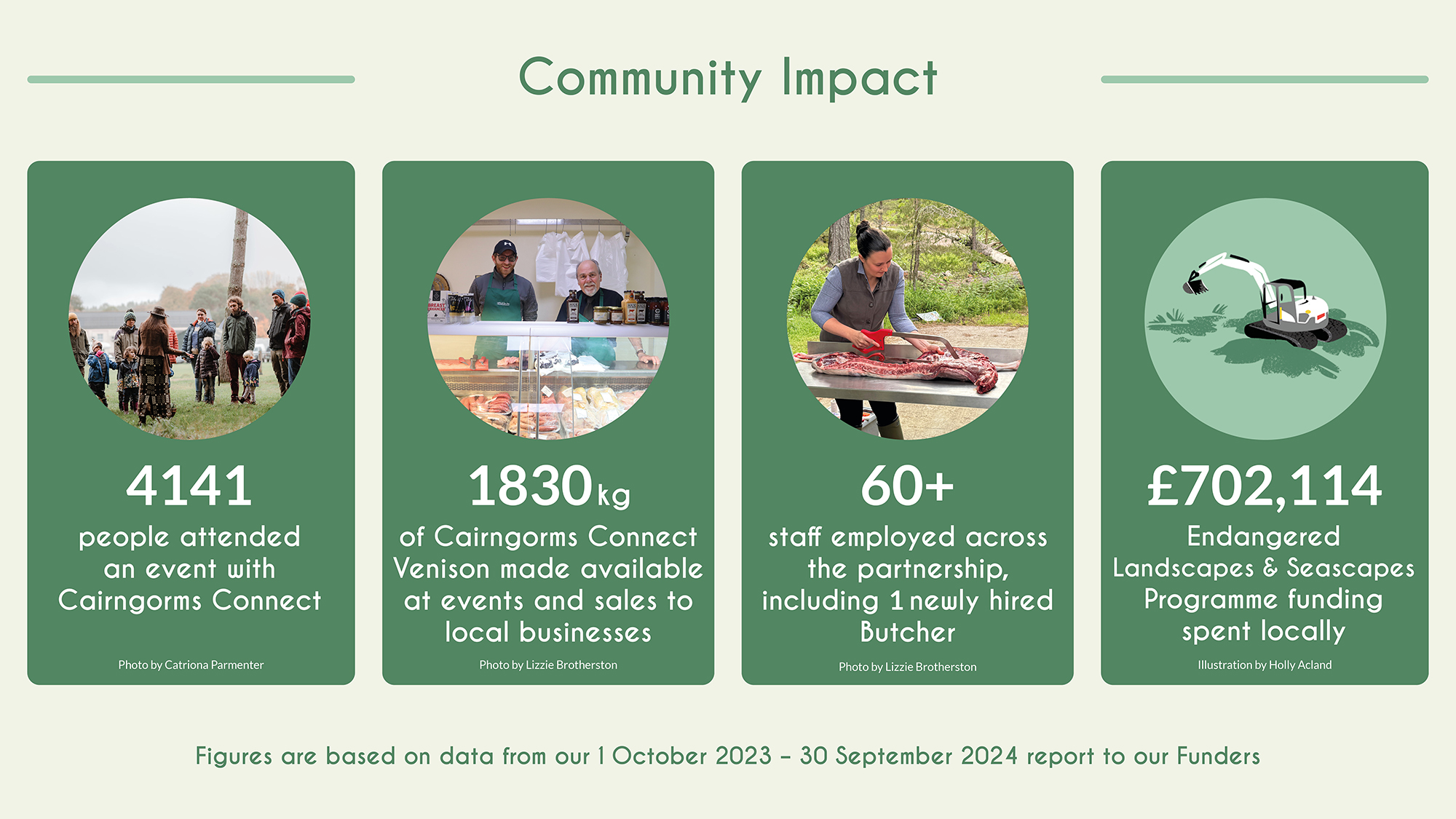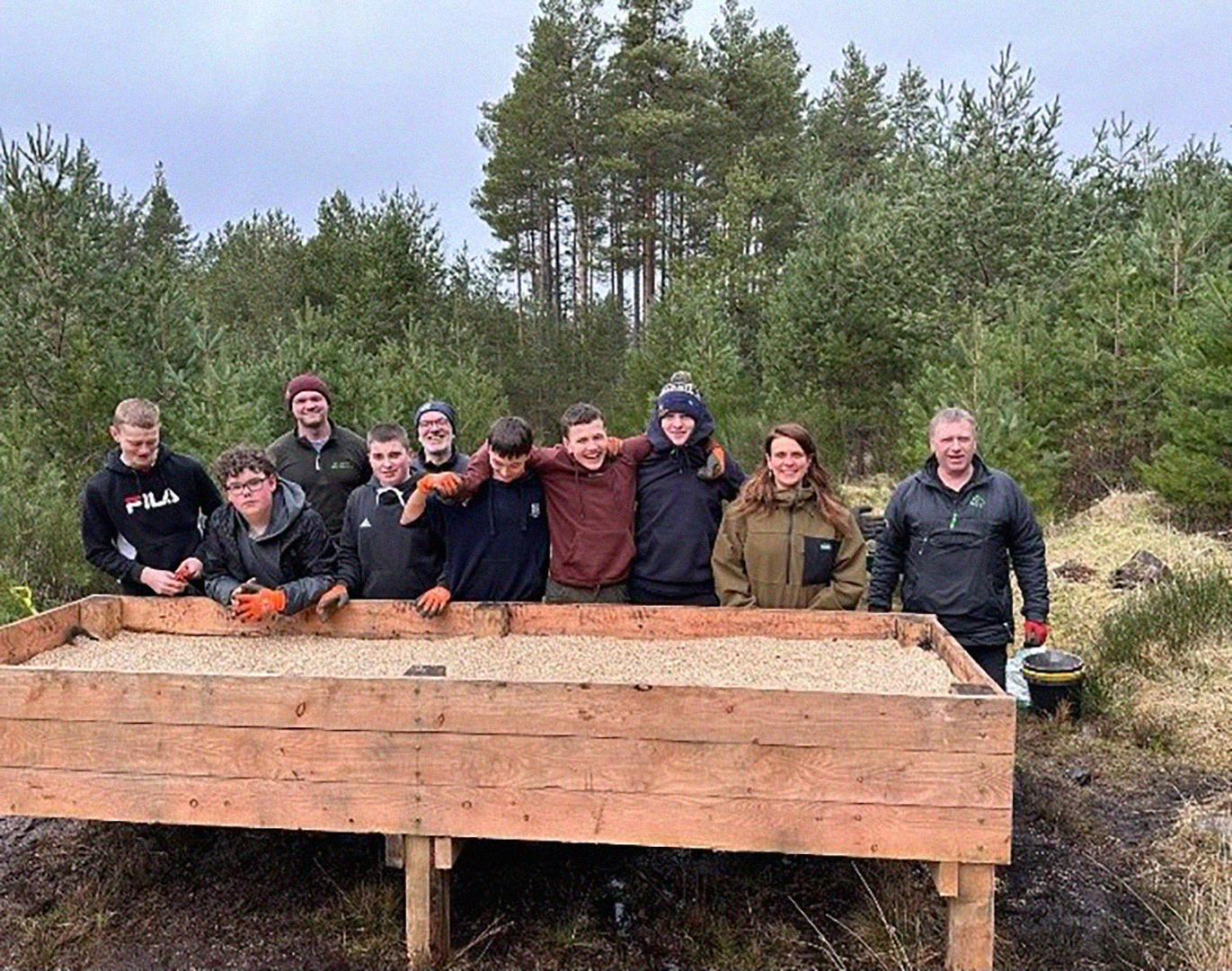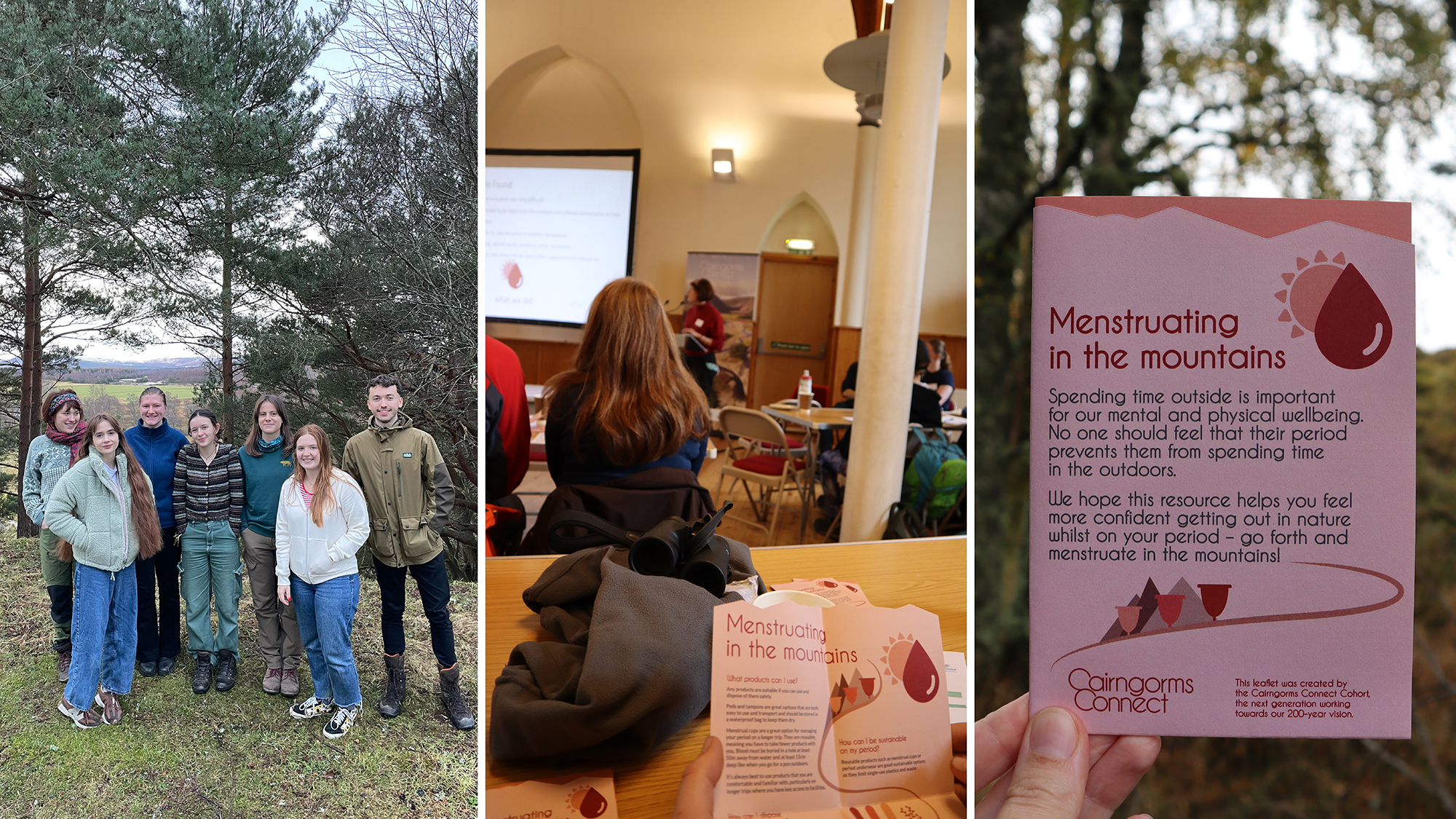

The cold, dark Winter months offer an invitation to pause and reflect. As the year draws to a close, another year towards our 200-year vision, we take time to review the highlights from 2024.
The Cairngorms Connect Partnership has had another jam-packed year, with marked progress across all areas from restoration delivery to communications and involvement, and science and monitoring.

The last 12 months have seen the reintroduction of Eurasian Beaver, after an absence of 400 years, and the release of European Wildcat into the Cairngorms Connect landscape.
People are at the heart of Cairngorms Connect and this year saw some exciting community projects: the significant growth of Cairngorms Connect Venison resulted in the employment of a young local butcher to keep up with demand; the Cairngorms Connect Youth Cohort developed a much-needed resource about menstruating in the mountains; 500 people joined us at Hill to Grill 2023; 55 people attended the 2023 Community Conference; and the creation of the beautiful and inspiring ‘Commonplace Book’, to name a few.

The Cairngorms Connect Predator Project’s Diversionary Feeding study was published by the Journal of Applied Ecology and other estates have picked up on our monitoring and testing interventions, adopting both in-forest cattle grazing and diversionary feeding.
We look forward to building on this work next year, developing our restoration practices and continuing to involve and collaborate with our local community.
We asked some Cairngorms Connect Partnership staff to share their 2024 highlights to shed light on the work behind the data.
We are continuing to develop new and meaningful opportunities for the next generation to get involved with the Partnership, whether it’s working with the inspirational Cairngorms National Park Junior Rangers, school groups, or our Youth Cohort.
 Students from Kingussie High School learn about native tree seeds with Forestry and Land Scotland staff Kevin Robertson (right). Photo by Brian Duff
Students from Kingussie High School learn about native tree seeds with Forestry and Land Scotland staff Kevin Robertson (right). Photo by Brian Duff
Kevin Robertson from Forestry and Land Scotland kicks things off: “My colleague Brian and I have been working with local young people in a partnership project with Kingussie High School and NatureScot to collect local native tree seeds with a view to growing them and planting them out into the forest as part of the Cairngorms Connect vision.
It has been brilliant to see the enthusiasm of these young people. Hopefully some of them will go on to become the foresters of the future, taking over from Brian and I, helping to restore native forests and carry on the work of Forestry and Land Scotland.”
 The Cohort group at a residential in January 2024 where they began developing the 'Menstruating in the Mountains' resource, which they presented at the Community Conference in September.
The Cohort group at a residential in January 2024 where they began developing the 'Menstruating in the Mountains' resource, which they presented at the Community Conference in September.
This year the Cairngorms Connect Youth Cohort, a group of local young people aged 18–25, worked together to reduce barriers and demystify having a period in the outdoors.
Cohort member Jessica Thompson explains: "As a young woman who spends a lot of time outdoors, I noticed a distinct lack of information and awareness around managing a period while in nature. Unfortunately, it still feels like a bit of a ‘taboo’ subject, so we wanted to contribute to the conversation and help answer some of the questions around how to ‘menstruate in the mountains’!”
Facilitated by Cairngorms Connect, the Cohort worked together to develop and deliver an online resource and printed poster which answer commonly asked questions to help people who menstruate manage a period in the outdoors.
Natural regeneration spreading up the slopes at Wildland Cairngorms. Photo: Donnie Ross
Deer management continues to play a key role in our habitat restoration work across the Cairngorms Connect Partnership landscape. Donnie Ross, Gamekeeper for Wildland Limited, describes the effects he is seeing as a result.
“After 9 seasons of targeted deer management in the forests of Gaik and Glentromie, young trees of Birch, Alder, Willow, Rowan and Aspen are reaching for the skies and spreading beautifully across the heath moorland and hillsides.
When they come of height and abundance, we will reduce Deer management pressure. Deer play an important role in sculpting the thick swards of natural regeneration as we are trying at present in the east slope of Loch an t-Seilich and Creag Liath, the main Glen of Glentromie, Corrie Ruthven and Torcroy.
In the area above Gaick lodge, we have a prevailing west wind which blows down the glen and with no seed source from the south end of Gaick. Here, natural regeneration is taking longer, but it is occurring thanks to continued targeted Deer management. Eventually we hope to see the native woodland of the Glen restored, and home to a healthy sustainable Deer population.”
Cows on RSPB Scotland Abernethy Reserve helping to break up the field layer and create space for a variety of flora and fauna. Photo: Mike Butler
Collaboration and partnership within landscape restoration work is vital, and opportunities to expand these opportunities continue to grow year on year. Mike Butler, Assistant Warden for RSPB Scotland, works with local graziers and their cows to mimic the effects of large extinct herbivores to help create field layer disturbance and bring back missing natural processes.
“The highlight for me this year is that we are now working with three local graziers and their 200 cattle to graze 2000 hectares on RSPB Scotland’s Abernethy Nature Reserve, all without a need for fencing. We are seeing shared benefits both for the pine forest habitat and for the graziers who can overwinter their cattle on our land – opening up new opportunities for them. So many positives have come from grazing the forest and I hope the story continues.”
Cairngorms Connect staff member photographs a Beaver swimming across a Loch at Wildland Cairngorms after one of the reintroductions this year. Photo: Ronan Dugan
The Cairngorms Connect landscape has seen the return of Wildcats and Beavers. The Beavers were a particular highlight for Tara Meehan, Regeneration Coordinator at Wildland Limited.
“This year, we have seen a number of Beaver releases across various sites in Wildland Cairngorms. It’s been fascinating to watch the re-establishment of this species since their release, their engineering of these habitats and the successful breeding locally this year. Seeing these successful reintroductions alongside the regenerating woodlands in the Cairngorms, has been a true highlight for me.”
Beavers have also been released at RSPB Scotland Insh Marshes, and Warden Julie Ellis describes the feeling of being at one of the releases.
“Actually seeing a Beaver walking to the water’s edge and then swimming across the water made me unexpectedly emotional. I felt incredibly privileged to be present to see the first Beaver returning to this suitable wetland habitat after an absence of hundreds of years. It was wonderful to see that this historic Beaver territory could still provide for the Beavers’ needs – and to be part of ensuring that that remains the case in the future.”
Read more about our year of living alongside Beavers here.
Photo of a Black Grouse, just visible in the blizzard conditions on NatureScot's Invereshie and Inshriach National Nature Reserve. Photo: Alexander Kennard
Science and monitoring are incredibly important to the work we do as it helps inform and support our restoration work.
Alexander Kennard is involved in Monitoring work as part of his Reserve Officer role with NatureScot. “My more memorable highlights this year come from our Black Grouse surveys on Invereshie and Inshriach National Nature Reserve. Early mornings, blizzards and bothy nights provided a backdrop for the work carried out in this small chunk of the landscape, helping me appreciate the amount of fieldwork required to monitor the wider Cairngorms Connect partnership area. We were also able to trial new audio recording devices at the same time, which will hopefully help us gather more accurate data on species in the area.”
Recent graduates, employed as part of the Centre for Landscape Regeneration’s Future Leaders Programme, monitor a Twinflower plot on RSPB Scotland Abernethy Reserve. Photo: Lizzie Brotherston
As the Endangered Landscape and Seascape Programme funding comes to a close Pip Gullett, Senior Conservation Scientist for the Cairngorms Connect partnership, reflects on the monitoring that has taken place so far.
“A major highlight for us this year was finishing all the monitoring for our “species” indicator. We completed moth, bird and vegetation surveys at 4 fixed sites each year during 2019–2024 (except 2020!), as well as at 80 further sites in one year each.
In total across the five years of the project, we identified 15,893 moths, 2014 birds and completed 2200 vegetation quadrats, with the involvement of over 30 staff and volunteers.
This will provide an amazing baseline for future monitoring, enabling us to see whether species are returning as habitats recover over the coming decades. It will also give us a great snapshot of what these plant and animal communities look like right now in areas with different management, helping us to understand how our management is impacting species.
Twinflower patches that were planted in 2014 were monitored this summer, to see how well they were growing 10 years on. Most of the 12 monitored patches were looking great, with plenty of growth and some even spreading to be bigger than nearby natural patches.”
Click here to download our Highlights Report.
Rosie Beetschen joins a day of Seed Establishment Trials in the beautiful and remote Strath Nethy to learn about how Cairngorms Connect are working to grow and expand our native forests. Listen or read.
Rosie Beetschen reflects on the Cairngorms Connect Community Conference earlier this month, and an amazing year of projects, fieldwork and volunteering